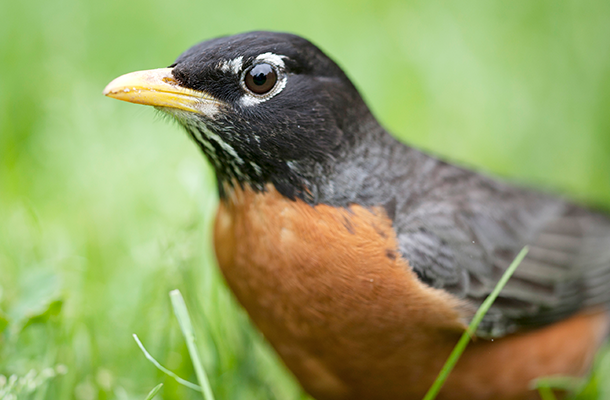Press Release
August 12, 2020
City of Madison Passes Bird-Safe Glass Ordinance
On August 4, the Madison Common Council unanimously adopted the state’s first bird-friendly building ordinance. Introduced by Alders Marsha Rummel and Keith Furman, drafted by City staff, and revised with input from American Bird Conservancy (ABC), the city-wide ordinance will require new large construction and expansion projects to use modern bird-safe strategies and materials that allow birds to see glass. The new requirements are expected to dramatically reduce bird mortalities. The ordinance goes into effect October 1, 2020.
The American Robin, Wisconsin’s state bird, and other species will be safer in Madison, Wisconsin, thanks to a new ordinance adopting bird-friendly building standards. Photo © Michael Stubblefield
“The well-being of birds and people in Wisconsin are very intertwined, from the economic benefits of tourism and birdwatching to free services like pest control and pollination,” says Matt Reetz, Executive Director of Madison Audubon, one of the organizations that has been advocating for the ordinance. “We really must do what we can to protect birds, and this is a straightforward and important step in doing so. I’m proud of our city for taking this step.”
The ordinance was developed by the City of Madison, in consultation with planners from other cities that have implemented similar bird-friendly standards. A coalition of local environmental groups studying the bird-collision problem in Madison also provided strong support for the ordinance. This group, called the Bird Collision Corps, is coordinated by Madison Audubon, University of Wisconsin-Madison’s (UW-Madison’s) Facilities Planning and Management Department and Department of Forest and Wildlife Ecology, the Dane County Humane Society’s Wildlife Center, and ABC.
“The City of Madison’s unanimous adoption of bird-friendly building standards puts it at the front of a growing movement of communities that are doing their part to save the nearly 1 billion birds that die after colliding with glass in the U.S. each year,” says Bryan Lenz, ABC’s Glass Collisions Program Manager. Lenz has been involved in the Bird Collision Corps and development of the Madison ordinance. “Not to mention that saving birds is the right thing to do, both ethically and for a healthy environment,” he adds.
Research shows that residences that are one to three stories tall account for 43.6 percent of collision-related fatalities, while 56.3 percent of collisions happen at low-rise buildings (four to 11 floors). Those two types of buildings account for most of Madison’s cityscape. Only 0.1 percent of bird deaths happen after collisions with buildings 12 stories or higher.
“It is my hope that with greater understanding and appreciation of birds in the design process, we can ensure our buildings on campus do less harm,” says Aaron Williams, who is UW-Madison Facilities Planning and Management’s Assistant Campus Planner and Landscape Architect, and one of the major partners on this project. He continues, “We can design and build for greater equity and purpose in regard to the natural world. What’s good for birds is ultimately good for the rest of us.”
Brenna Marsicek, Communications and Outreach Director with Madison Audubon and Coordinator of the Bird Collision Corps, notes: “Madison’s new city ordinance is a great start and will be a really important conservation tool to protect birds from preventable deaths. It would be great to see other cities in the area adopt similar requirements, to make this a better place in general for birds and bird-lovers.”
Leading up to this encouraging news, in July 2019, the U.S. House of Representatives passed H.R. 919, Bird-Safe Buildings Act, to reduce bird mortality by calling for federal buildings to incorporate bird-safe building materials and design features. This is on the heels of the New York City Council passing the country's most comprehensive bird-friendly buildings law, in December 2019.
“Bird-friendly building design should not be seen as an add-on or an extra,” said Dr. Christine Sheppard, Glass Collisions Program Director for American Bird Conservancy. “Many strategies for controlling heat, light, and even security can be bird-friendly strategies, too. These can be incorporated into almost any building style, but should be built into project design from the outset to minimize additional costs. That's why this kind of legislation is so important.”
These advancements are coming not a moment too soon for declining bird species. A study published in Science in September 2019 reported that the U.S. and Canadian breeding bird population dropped by more than one-quarter since 1970. Glass collisions are one major cause of this loss, killing up to 1 billion birds in the U.S. each year. According to New York City Audubon’s Project Safe Flight, 90,000 to 230,000 birds die each year during their migrations through New York City alone. Fortunately, both home and commercial windows can easily be made safe for birds. Get resources and ideas for solutions here.
Media Contacts:
Madison Audubon: Brenna Marsicek, Communications Director | bmarsicek@madisonaudubon.org
American Bird Conservancy: Jordan Rutter, Director of Public Relations | jerutter@abcbirds.org
Expert Contacts:
Madison Audubon: Matt Reetz, Executive Director | mreetz@madisonaudubon.org
American Bird Conservancy: Bryan Lenz, Glass Collisions Program Manager | blenz@abcbirds.org




